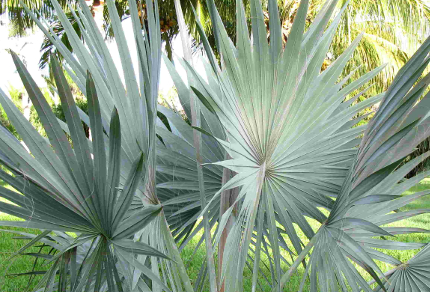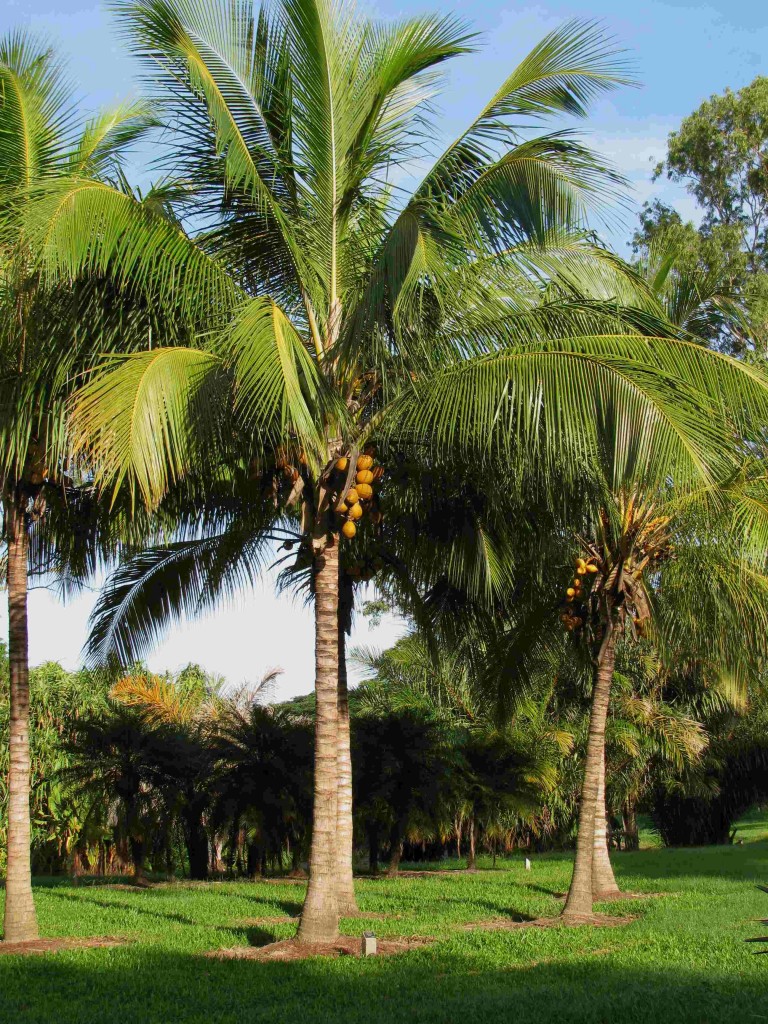
Coconut Palm (© Magi Nams)
While darkness still lingered beneath trees, I cycled away from the house and into the open twilight of streets and the river park. The river was quiet, withdrawn from shores it had flooded so deeply below Aplins Weir last weekend. Above the weir, rowers rested on still, green water, their boats white slivers pointing upstream. On the riverside path, the pools of floodwater that Vilis and I splashed through on Sunday were shrunken to damp pavement and patches of thin mud.
When I crossed the bridge over the stagnant creek near Palmetum Park, I again spotted Krefft’s turtles, twenty-five of them, hanging in the water, their heads breaking the surface. I’d never seen so many turtles in one place before. Were they foraging? Turtles paddling on both sides of the bridge faced the bridge, as though it, itself, were somehow the attraction. They merited more attention, but I was destined for the Palmetum.
After locking my bike to the iron fence bordering the park, I slipped through the gate and walked among an impressive variety of palms inhabiting various habitats. Charmingly, impressions of palm fronds were embossed into sections of the cement path that branched into gravel tracks leading into different vegetation zones. The rainforest and swampforest habitats were dim and dank, with cascading palms forming dense mounds a metre and a half high bordering the path, far below towering trees. I thrashed through spider silk crossing the path and slapped at mosquitoes, noting ten Australian brush-turkeys, all with their red heads and necks and yellow wattles much duller in colour than those of that vibrant male Vilis and I followed at Cape Pallarenda on January 10.
Beyond a gazebo flanked by cycads and a dark, dank waterway, the gardens opened into savannah. White ibises foraged in grassy meadows, and two wallabies had a boxing match near a grove of open-country palms. Both wallabies were a warm brown colour and had dark-tipped ears, a faint white line on the side of their faces, and grey chests, bellies, and limbs. Their dark forepaws punched and poked and pulled at each other’s face and neck. One of the two, which was much larger than the other, hopped into the air and heaved out a kick with a huge hind foot. Then they both stopped to groom themselves, the smaller animal leaning back and giving its side a good scratch. Remaining together, but no longer boxing, the pair began to forage among the grasses, the larger wallaby tail-propping while stepping forward with its hind feet.
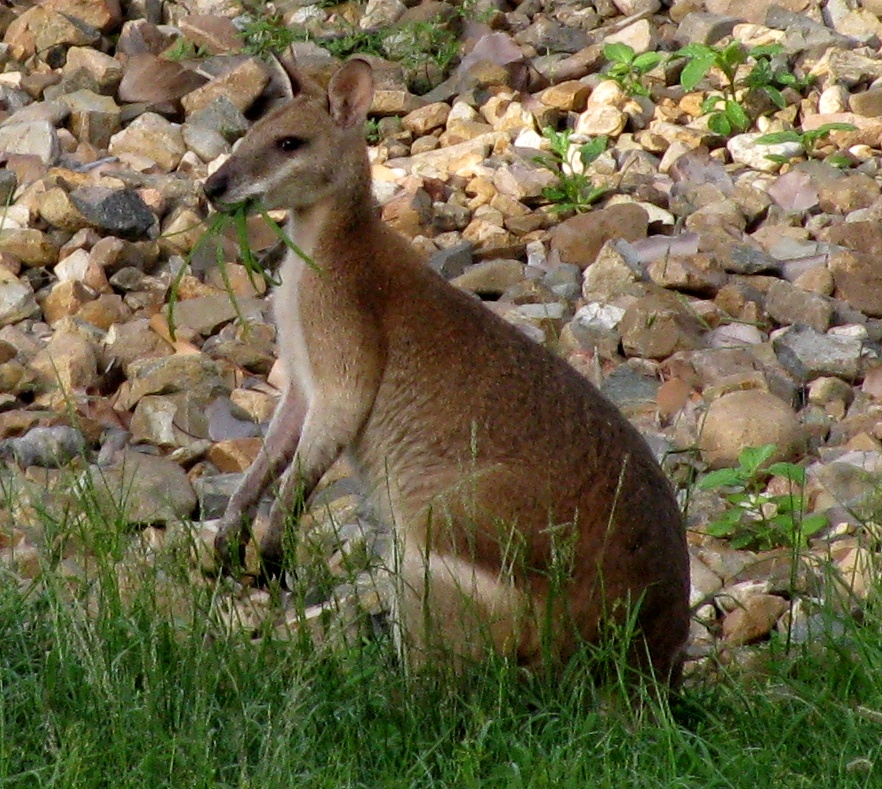
Agile Wallaby (© Magi Nams)
Initially, I thought the wallabies were two males fighting over a breeding female. However, after observing the size difference between the two and their foraging together, I decided they were likely a male (the big one) and female that had had a tiff of some sort or just enjoyed a spot of boxing. Since I had yesterday flipped through my mammal guide and viewed online photographs of various macropods inhabiting the Townsville area, I identified these two as agile wallabies, which are apparently common in tropical coastal Australia and found in many grassy woodland habitats.
I must say that until I bought my copy of A Field Guide to the Mammals of Australia,1 which was written by Peter Menkhorst and illustrated by Frank Knight, I had no idea how many kinds of hopping mammals inhabit this country. Excluding rabbits and hares, which were introduced by Europeans, the many landscapes of Australia are traversed by hopping mice, rat-kangaroos, bettongs, woylies, potoroos, tree kangaroos, malas, wallabies of many sizes and appearances, wallaroos, grey and red kangaroos, euros, toolaches, quokkas, monjons, nabarleks, and pademelons. Some of the names sound as though they belong in a Star Wars movie, and some of the critters are certainly cute enough to have had a place there. The larger of these hoppers fill the same ecological niche as do the ungulates – the deer, elk, wild sheep and goats, and so on – in North America, while the medium-sized species fill the niche occupied by large rodents like woodchucks and marmots, and the smaller, those niches occupied by smaller rodents. Already, Vilis and I have noticed our visual search image for mammals shifting from what we were familiar with in Canada to what we encounter here, south of Wallace’s Line.
Leaving the wallabies to their breakfast, I strolled through moist tropical savannah, where moisture-loving palms grew in thick, messy-headed clumps, and a royal spoonbill and great egret hunted in shallow water left by last week’s storms. In the succulent and cactus garden, a xerophytic palm tossed out fan fronds that resembled plates of daggers, some positioned low, as if they were shields, and others slanted at sharp angles from the trunk, like an arsenal at the ready. Nearby, a tiny skink skittered along an agave leaf a metre and a half long, and bees visited a lush, white cactus blossom.
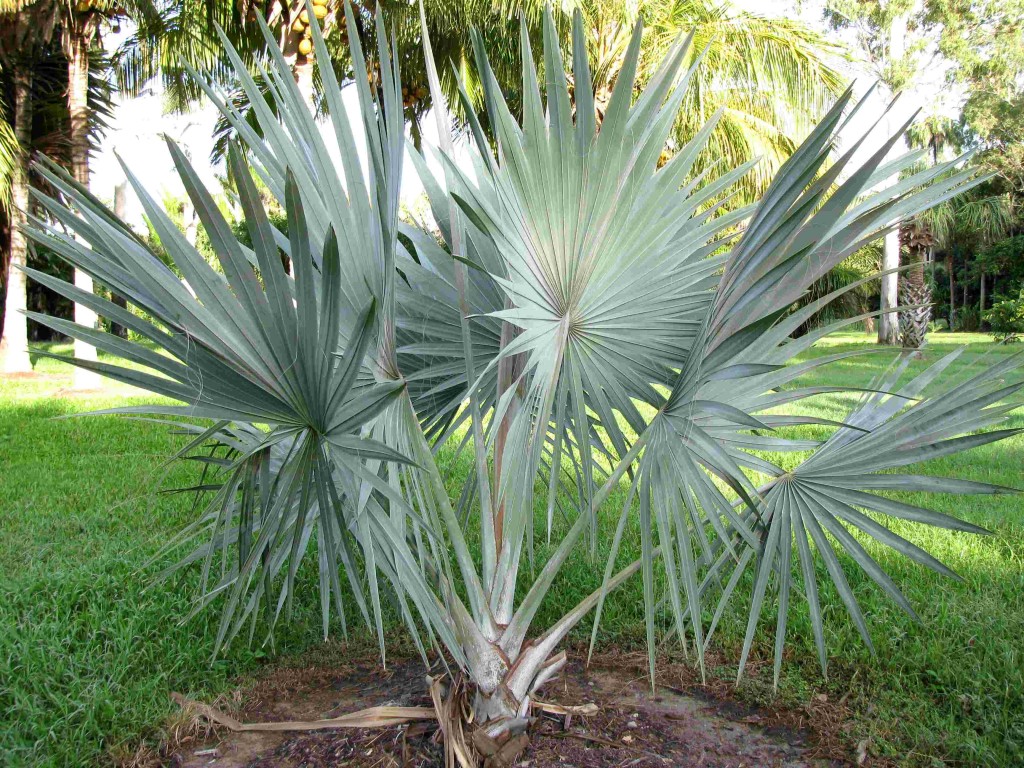
Fan-leaved Palm (© Magi Nams)
Beyond the xerophytic gardens, a planting of soft-fronded coconut palms bearing ochre-coloured fruits provided a striking contrast to blue-grey, stiffly-pleated fronds of a row of stocky, almost globular, fan-leaved palms. Beyond these, a pond was edged by dense clumps of dishevelled-looking, water-tolerant palms with skirts of dead leaves. Two plumed whistling ducks squeaked at the water’s edge and then took to flight, as did a comb-crested jacana trailing its incredibly long toes. Purple blossoms of water lilies were rich, multi-petalled cups on long stalks raised above broad leaves puckered into teeth at their edges and riding wind-ruffled water. On shore, stands of thin-trunked lipstick palms formed dense, eye-catching clusters of vivid green fronds above scarlet leaf bases.
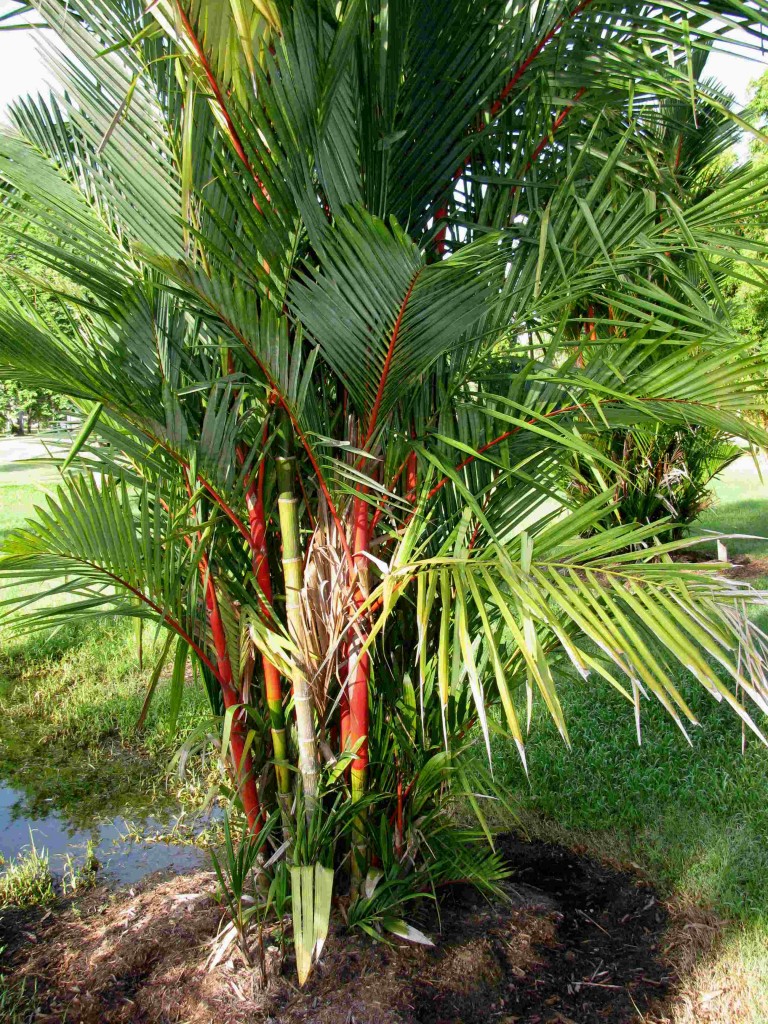
Lipstick Palm (© Magi Nams)
With the vision of breakfast gnawing away my interest, I unlocked my bicycle and pedaled the 5 kilometres home on the river path. Beside it, pink lotus blossoms on the river reached for the sun, and on the ground, a blue-winged kookaburra stabbed its chisel-beak at hidden prey.
After supper, a pheasant coucal whooped out its “coop-coop-coop” call from a thicket of shrubs on the far side of the river. West of the golf course, the waterway had retreated into its channel and surprisingly exposed a long spit of rock on which two people stood fishing. No doubt the tide was low. I so often forget that the Ross River is very much a tidal river, with its character downstream from Aplins Weir being that of an estuarine river, while its character upstream of the weir is that of a freshwater river.
In the west, a mass of cumulus clouds was shot through with gold and pink. The sunset cast its reflection onto clouds above Castle Hill and painted periwinkle onto the Many Peaks Range. Heated air licked at my calves, the atmosphere thick and oppressive. Vilis tried to inhale deeply, but eased back after several attempts.
“It’s hard to breathe deeply,” he told me. “The air isn’t refreshing at all. It feels like something’s building.”
Another deluge, perhaps. All week, the sun has been scorching, the humidity riding high, making for restless nights and shade-seeking days. On Sunday, one of the young mothers at the church service we attended in Oonoonba said that after the rains stop, the weather is like spring for the rest of the year. In Canada, spring is the beacon we push toward at the end of a long, cold winter. Here, with seasons swapped by the equator and molded by tropical highs and lows, the beacon comes at the end of the Wet.
Reference:
1. Peter Menkhorst and Frank Knight. A Field Guide to the Mammals of Australia. 2004. Oxford University Press, South Melbourne, Victoria, 273 p.

